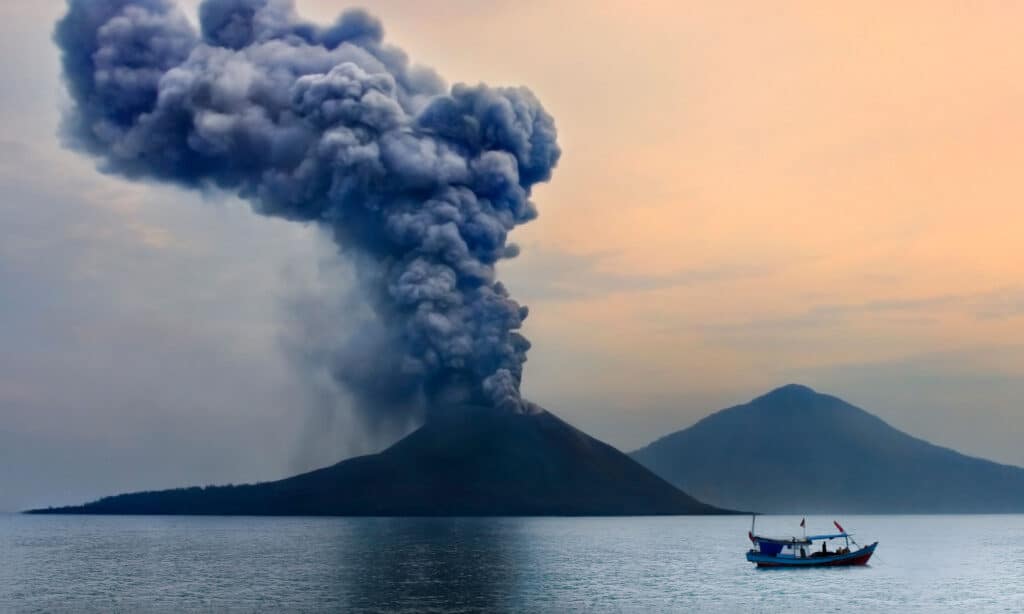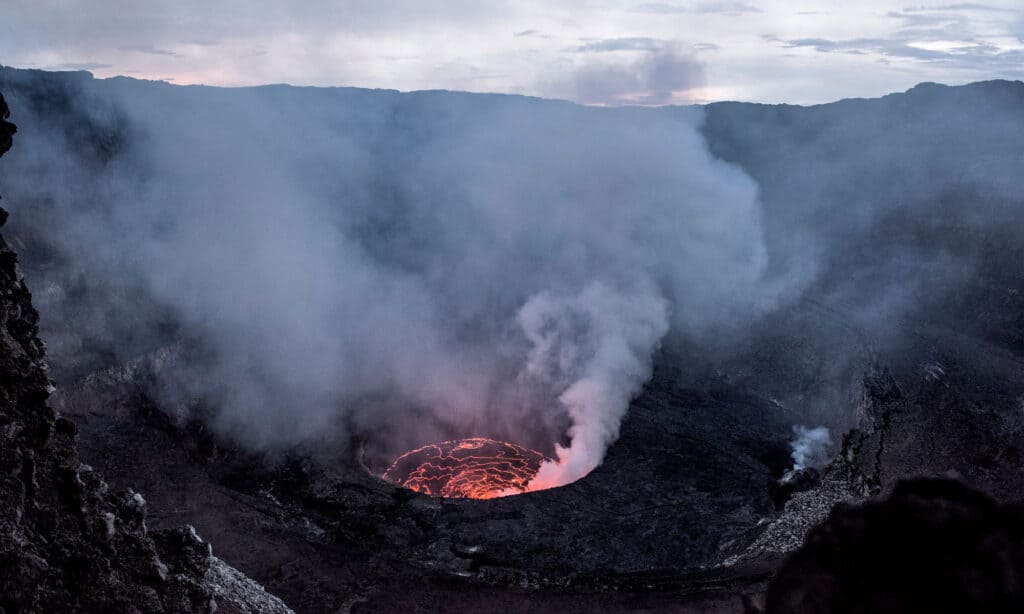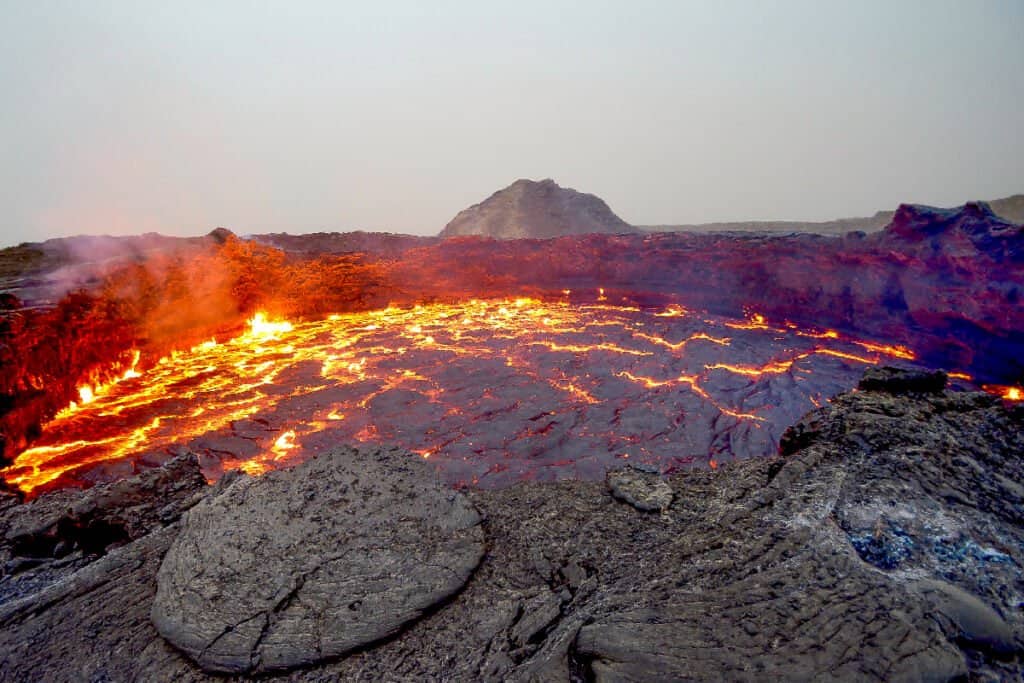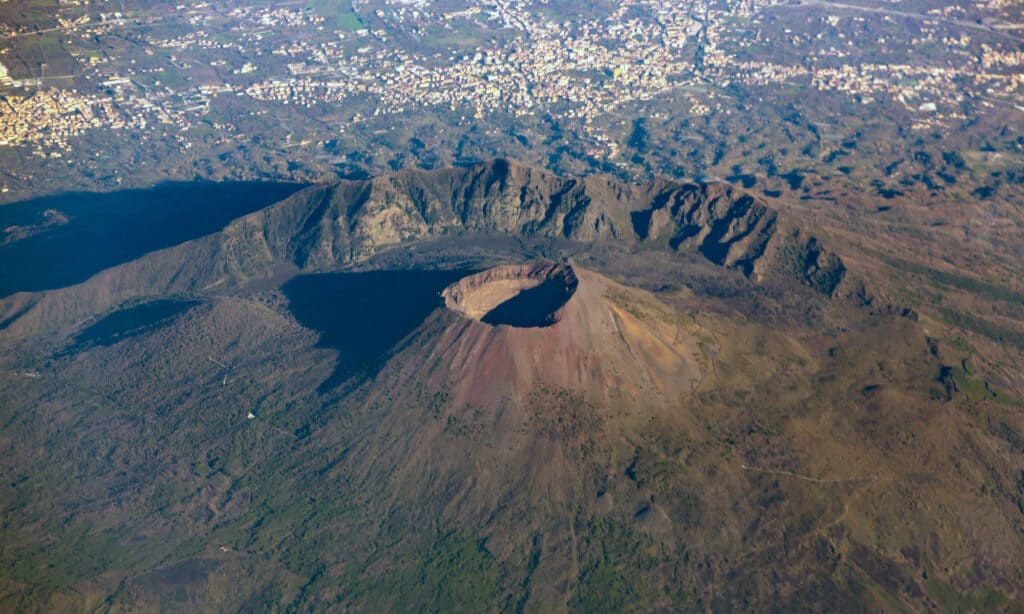Earth is a living planet. Even below its calm surface lies ever-shifting tectonic plates, rivers of liquid metal, and chambers of 2,000℉ magma. But are there actual living, breathing organisms? Can a living creature withstand extreme temperatures and thrive at the bottom of a volcano?
Keep reading to discover what lives at the bottom of a volcano, what animals make their homes around volcanoes, and the world’s most dangerous, active volcanoes.
What is a Volcano?

A volcano is an opening in the earth’s surface where hot material like lava, ash, and gas can escape.
©iStock.com/Byelikova_Oksana
A volcano is an opening in the earth’s surface where hot materials like lava, volcanic ash, and gases can escape. Eruptions occur by building pressure from dissolved gas. As magma rises, the pressure decreases, and gases form bubbles. The method by which these materials erupt out of the volcano depends on their gas content and other compositions.
Some volcanoes have massive explosions, sending materials into the sky, whereas others might erupt more gently with slow-flowing rivers of lava. Volcanic areas usually consist of mountains formed over thousands of years from rock, ash, and other collected materials.
There are three types of volcanoes: active, dormant, and extinct. Active volcanoes are erupting now, have erupted recently, or are expected to erupt in the near future. Dormant volcanoes are not erupting but may in the future. Extinct volcanoes will likely never erupt again.
Where Can You Find Volcanoes?

75% of the world’s volcanoes are underwater.
©jo Crebbin/Shutterstock.com
Most people think of volcanoes as those huge mountains on earth above sea level, but 75% of the world’s volcanoes are underwater. Most volcanoes are only in a few areas around the boundaries of tectonic plates. One of the most popular volcanic areas is the Ring of Fire, an arc around the Pacific Ocean.
Other volcanoes form islands over hot spots in the middle of tectonic plates. However, most of the volcanoes in the world are on the ocean floor, hidden out of sight.
What may be surprising is that earth is not the only planet with volcanoes. There are active volcanoes in our solar system erupting right now. NASA took pictures of active volcanic eruptions on Jupiter, Saturn, and Neptune. Extinct volcanoes cover planets like Venus and Mars.
How are Volcanoes Formed?
Volcanoes form as magma rises and pushes up the earth’s crust. Magma rises for three different reasons. First, magma can rise when tectonic plates move away from each other, filling the gap. Underwater volcanoes can form when this happens.
Secondly, tectonic plates can move towards each other, forcing the earth’s crust into its exterior. High heat and pressure melt the crust and cause magma to rise. Lastly, volcanoes form over hot spots. Hot areas inside the earth heat the magma, allowing it to rise as it becomes less dense. Each way is different, but all can form volcanoes.
What Lives at the Bottom of a Volcano?

Life can’t survive in molten rock. However, some animals live near active volcanoes.
©iStock.com/GlobalP
Life requires water, a way to manufacture nutrients, and heat. Unfortunately, even extremophiles, organisms that live under extreme circumstances, can’t survive in molten rock. So, what lives at the bottom of a volcano? Apparently, nothing that we know of.
However, there is evidence that life exists near active volcanoes or just inside of them. There is only one animal seen living inside a volcano. Scientists researching Kavachi, an enormous underwater volcano, captured video evidence of sleeper sharks living inside the crater.
Researchers always believed that active underwater volcanoes produced too much heat and acidity for fish to survive, but these sharks thrive around this massive volcano.
What Lives Near a Volcano?

Some animals like sleeper sharks and sea lions thrive in hot, acidic environments.
©mbrand85/Shutterstock.com
Living organisms may not be able to survive in the extreme environment at the bottom of a volcano. Still, the heat it produces around it is necessary for the existence of life. Are there plants and animals that live and grow around volcanic activity? Actually, yes.
Plants
Volcanic eruptions can devastate land in the short term, but what’s left behind is some of the world’s most fertile soil. Some plants, like dogwood and huckleberry, can even survive an eruption.
Plants that grow near volcanoes include shrubs, ferns, and moss. Some of the most colorful and stunning flowers on earth, such as mountain orchids and birds of paradise, grow in volcanic soil.
Animals
The ecosystem around an active volcano typically doesn’t provide a safe environment for humans, plants, and animals. But some animals, for whatever reason, thrive in these scorching, acidic environments.
Here is a list of animals that live near active volcanoes:
- Pacific sleeper sharks
- Lesser flamingoes
- Shrimp
- Crab
- Marine iguanas
- Penguins
- Limpets
- Barnacles
- Sea lions
- Vampire ground finch
- Thermophiles (microorganisms)
Many plants and animals feed off the nutrients from cooled lava and ash and even feast on animals that wander too close. The animals may retreat during an eruption and return once heavy rainfall cools down the area. Over time, creatures learned to adapt to these harsh environments.
What Are the Most Dangerous Volcanoes in the World?

Mount Vesuvius was responsible for the destruction of Pompeii.
©iStock.com/Cylonphoto
Volcanoes are incredible creations that come with deadly consequences. While some volcanoes produce slow-flowing lava that gives people and animals time to escape, other volcanoes explode, sending lava, ash, and rocks flying in the air. Cities and towns throughout history have been caught off guard by these spewing mountains and, unfortunately, paid the price.
Cotopaxi in Ecuador is one of the most dangerous volcanoes in the world, sitting just above a highly populated city. It is one of the world’s tallest, most active volcanoes, producing over 50 eruptions since the 16th century. The last eruption was in 1904, but researchers believe it is just a matter of time before it happens again.
Mount Vesuvius was responsible for the destruction of Pompeii in 79 AD. And while it has only seen eight eruptions in the last 17,000 years, each one produced fast-moving streams (430 miles per hour) of volcanic matter. Vesuvius is close to the city of Naples and other populated towns, and the government is already preparing for a future volcanic event.
What is the World’s Largest Active Volcano?

Mauna Loa is the world’s largest active volcano.
©MNStudio/Shutterstock.com
Mauna Loa (“long mountain”) is the world’s largest active volcano. It is in Hawaii and reigns supreme as the planet’s most massive stand-alone volcano. This volcano takes up half of an entire island and measures 60 miles long and 30 miles wide. Since the mid-1800s, Mauna Loa has erupted 33 times, averaging every six years. The last eruption was in 1984.
The photo featured at the top of this post is © iStock.com/GlobalP
Thank you for reading! Have some feedback for us? Contact the AZ Animals editorial team.






